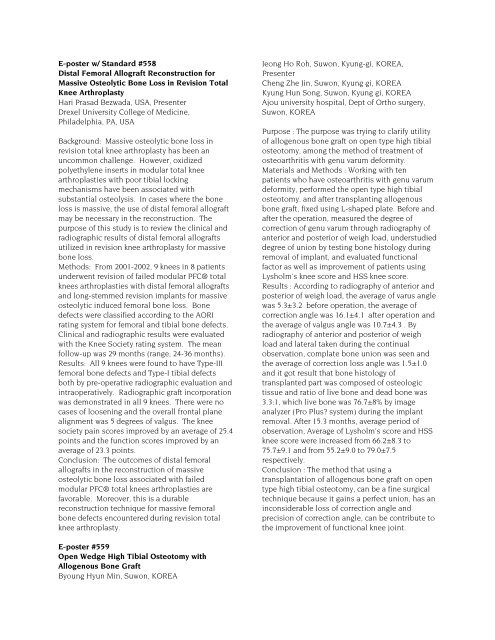POSTER ABSTRACTS - ISAKOS
POSTER ABSTRACTS - ISAKOS
POSTER ABSTRACTS - ISAKOS
Create successful ePaper yourself
Turn your PDF publications into a flip-book with our unique Google optimized e-Paper software.
E-poster w/ Standard #558<br />
Distal Femoral Allograft Reconstruction for<br />
Massive Osteolytic Bone Loss in Revision Total<br />
Knee Arthroplasty<br />
Hari Prasad Bezwada, USA, Presenter<br />
Drexel University College of Medicine,<br />
Philadelphia, PA, USA<br />
Background: Massive osteolytic bone loss in<br />
revision total knee arthroplasty has been an<br />
uncommon challenge. However, oxidized<br />
polyethylene inserts in modular total knee<br />
arthroplasties with poor tibial locking<br />
mechanisms have been associated with<br />
substantial osteolysis. In cases where the bone<br />
loss is massive, the use of distal femoral allograft<br />
may be necessary in the reconstruction. The<br />
purpose of this study is to review the clinical and<br />
radiographic results of distal femoral allografts<br />
utilized in revision knee arthroplasty for massive<br />
bone loss.<br />
Methods: From 2001-2002, 9 knees in 8 patients<br />
underwent revision of failed modular PFC® total<br />
knees arthroplasties with distal femoral allografts<br />
and long-stemmed revision implants for massive<br />
osteolytic induced femoral bone loss. Bone<br />
defects were classified according to the AORI<br />
rating system for femoral and tibial bone defects.<br />
Clinical and radiographic results were evaluated<br />
with the Knee Society rating system. The mean<br />
follow-up was 29 months (range, 24-36 months).<br />
Results: All 9 knees were found to have Type-III<br />
femoral bone defects and Type-I tibial defects<br />
both by pre-operative radiographic evaluation and<br />
intraoperatively. Radiographic graft incorporation<br />
was demonstrated in all 9 knees. There were no<br />
cases of loosening and the overall frontal plane<br />
alignment was 5 degrees of valgus. The knee<br />
society pain scores improved by an average of 25.4<br />
points and the function scores improved by an<br />
average of 23.3 points.<br />
Conclusion: The outcomes of distal femoral<br />
allografts in the reconstruction of massive<br />
osteolytic bone loss associated with failed<br />
modular PFC® total knees arthroplasties are<br />
favorable. Moreover, this is a durable<br />
reconstruction technique for massive femoral<br />
bone defects encountered during revision total<br />
knee arthroplasty.<br />
Jeong Ho Roh, Suwon, Kyung-gi, KOREA,<br />
Presenter<br />
Cheng Zhe Jin, Suwon, Kyung gi, KOREA<br />
Kyung Hun Song, Suwon, Kyung gi, KOREA<br />
Ajou university hospital, Dept of Ortho surgery,<br />
Suwon, KOREA<br />
Purpose : The purpose was trying to clarify utility<br />
of allogenous bone graft on open type high tibial<br />
osteotomy, among the method of treatment of<br />
osteoarthritis with genu varum deformity.<br />
Materials and Methods : Working with ten<br />
patients who have osteoarthritis with genu varum<br />
deformity, performed the open type high tibial<br />
osteotomy. and after transplanting allogenous<br />
bone graft, fixed using L-shaped plate. Before and<br />
after the operation, measured the degree of<br />
correction of genu varum through radiography of<br />
anterior and posterior of weigh load, understudied<br />
degree of union by testing bone histology during<br />
removal of implant, and evaluated functional<br />
factor as well as improvement of patients using<br />
Lysholm's knee score and HSS knee score.<br />
Results : According to radiography of anterior and<br />
posterior of weigh load, the average of varus angle<br />
was 5.3±3.2 before operation, the average of<br />
correction angle was 16.1±4.1 after operation and<br />
the average of valgus angle was 10.7±4.3 . By<br />
radiography of anterior and posterior of weigh<br />
load and lateral taken during the continual<br />
observation, complate bone union was seen and<br />
the average of correction loss angle was 1.5±1.0<br />
and it got result that bone histology of<br />
transplanted part was composed of osteologic<br />
tissue and ratio of live bone and dead bone was<br />
3.3:1, which live bone was 76.7±8% by image<br />
analyzer (Pro Plus? system) during the implant<br />
removal. After 15.3 months, average period of<br />
observation, Average of Lysholm's score and HSS<br />
knee score were increased from 66.2±8.3 to<br />
75.7±9.1 and from 55.2±9.0 to 79.0±7.5<br />
respectively.<br />
Conclusion : The method that using a<br />
transplantation of allogenous bone graft on open<br />
type high tibial osteotomy, can be a fine surgical<br />
technique because it gains a perfect union, has an<br />
inconsiderable loss of correction angle and<br />
precision of correction angle, can be contribute to<br />
the improvement of functional knee joint.<br />
E-poster #559<br />
Open Wedge High Tibial Osteotomy with<br />
Allogenous Bone Graft<br />
Byoung Hyun Min, Suwon, KOREA
















